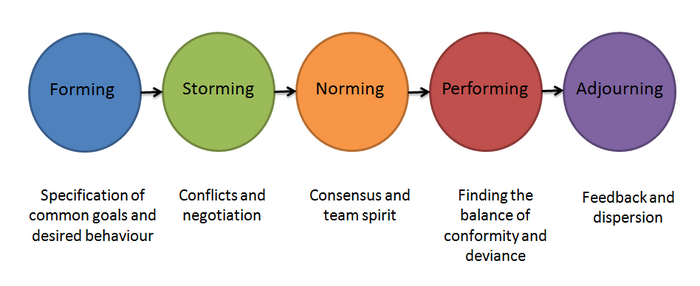Four Stages of Team Development
(→Further Development) |
(→References) |
||
| Line 124: | Line 124: | ||
==References== | ==References== | ||
| − | <references /> 1. | + | <references /> |
| + | 1. [http://www.lfhe.ac.uk/download.cfm/docid/3C6230CF-61E8-4C5E-9A0C1C81DCDEDCA2:''Bruce Tuckman’s Team Development Model''], Rebecca Nestor for ''Aurora'', 2013, | ||
Revision as of 14:55, 21 November 2014
Self-managed work teams need considerable time to show up its real aptitudes. What a group is capable of achieving depends in part on its stage of development. The team’s effectiveness can be improved if its members are committed to evaluate their work and receive feedback. However, the most important aspect is that every team member understands their development as a team.
Although every group’s development over time is unique, researchers have identified some stages of team development that many groups seem to pass through. The most famous model is the Four Stages of Team Development, developed by the psychology professor Bruce Tuckman in 1965. Tuckman proposed that all teams start somehow unproductive when they are first formed, and then they grow into a self-sufficient unit.
Although there have been other written variations from many authors, Tuckman’s stages of development – Forming, Storming, Norming and Performing – are a helpful technique to recognize the team’s behaviour and feelings during the process. Identifying and understanding why changes occur is a key component of the self-evaluation process. This can help the team reach the state of high-performance.
Contents |
Introduction to the Model
Dr. Bruce Tuckman developed the Forming Storming Norming Performing model, which describes the way most teams approach high performance. In 1965, he published this theory in his article Developmental Sequence in Small Groups.
Tuckman’s theory provides an explanation to the development and behaviour of a team, how new relationships are created as it generates maturity and capability, and how the lider modifies his way to lead.
As time goes by, teams experience different changes. Because of this, Tuckman demonstrated that there are three key points that determine the team’s effectiveness. These are content, which relates to the work the team does, process, that focuses on how the team deals with its objectives, and feelings, which is oriented to relationships between team members. Tuckman’s analysis advises that most groups centralize only on the content part. He exposed that even really solid teams can have low efficiency because of ignorance to the process and feelings parts.
Tuckman proposed that there are four stages which describe the team’s life-cycle. The group dynamics change from low efficient and troubled to highly productive where the hard work leads to good resolution of the problems that arise. Tuckman’s theory states that these four stages are needed and crucial for a constantly growing group to confront new threats, deal with the upcoming issues, search for solutions, organize the work and bring up results. The stages are briefly explained in the next table.
[Reference 1]
Forming
Stage 1: Immature group
- Feelings
- Process
- Content
The principal characteristics of the Forming stage are:
- Confusion: they haven't fully understood what work the team will do
- Uncertainty
- Assessing situation
- Testing ground rules: people start to work together
- Feeling out others: they make an effort to get to know their new colleagues
- Defining goals
- Getting acquainted
- Establishing rules
Storming
Stage 2: Fractional group
- Feelings
- Process
- Content
Characteristics of the Storming stage are:
- Disagreement over priorities: members question the worth of the team's goal and they may resist taking on tasks
- Struggle for leadership: team members may jockey for position as their roles are clarified
- Tension: members who stick with the task at hand may experience stress
- Hostility: conflict between team members' natural working styles
- Clique formation
Norming
Stage 3: Sharing group
- Feelings
- Process
- Content
The characteristics of this stage are:
- Consensus: people develop a stronger commitment to the team goal
- Leadership accepted: the leader’s authority is respected
- Trust established: team members know one-another better, they may socialize together, and they are able to ask each other for help and provide constructive feedback
- Standards set
- New stable roles
- Co-operation
Performing
Stage 4: Effective group
- Feelings
- Process
- Content
The principal characteristics are:
- Successful performance: hard work leads, without friction, to the achievement of the team's goal
- Flexible, task roles
- Openness
- Helpfulness
- Delusion, disillusion and acceptance
Further Development
Adjourning
Stage 5: Disbanding group
- Feelings
- Process
- Content
This stage is characterized by:
- Disengagement
- Anxiety about separation and ending
- Positive feeling towards leader
- Sadness
- Self-evaluation
References
1. Bruce Tuckman’s Team Development Model, Rebecca Nestor for Aurora, 2013,
![[1]](/images/thumb/c/c2/Table_-_Four_Stages_of_Team_Development.png/700px-Table_-_Four_Stages_of_Team_Development.png)
